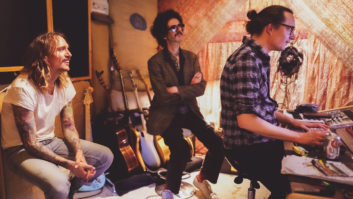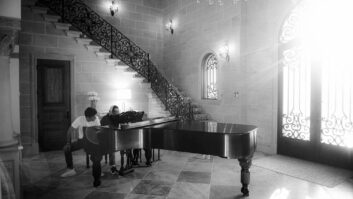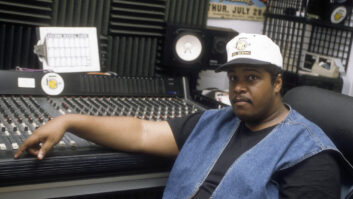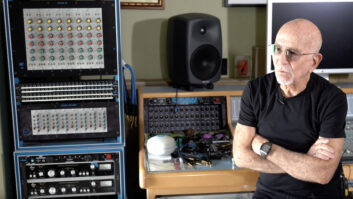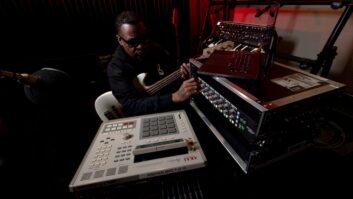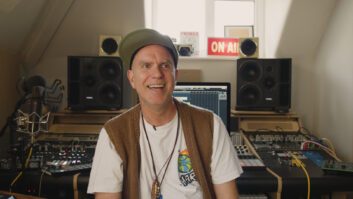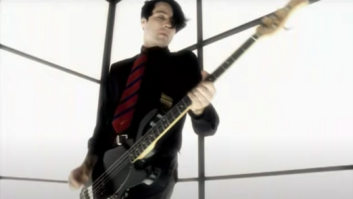The Darkness, from left: bassist Richie Edwards, drummer Ed Graham, vocalist/guitarist Justin Hawkins and guitarist Dan Hawkins
The members of British heavy rock band The Darkness don’t take themselves too seriously. With tongue somewhere near cheek, they say that their concerns during the recording of their new album, One Way Ticket to Hell’…And Back, included “the exhaustion and the fear, the pressure, paranoia and pan pipes, the breakdowns and the breakups, the sackings, sitar solos and endless studio sessions.”
Mix will leave the “paranoia,” “breakdowns” and “sackings” to the tabloids, but we definitely want to know more about the “endless studio sessions.” The man in the know is Roy Thomas Baker, the legendary producer behind pioneering albums by Queen, The Cars, Journey, Foreigner, Devo and many, many more.
The pairing of Baker and The Darkness is a marriage made in heaven, and has been in the cards ever since the band entered the public consciousness with Permission to Land, which sold some 3.5 million copies in 2003. Take a lead singer (dis-)graced with leotard suits and a balls-in-the-bench-vice falsetto, add music that takes its inspiration from 1970s hard rock, season with lots of operatic pomp, and you have a band that can lay claim to being the 21st-century heirs to the likes of Led Zeppelin, Queen, AC/DC, Slade and other rock bands from rock’s golden age.
Baker’s name, meanwhile, will forever be associated with Queen albums such as Queen II and Night at the Opera, which contained the track “Bohemian Rhapsody,” the band’s ode to rock ‘n’ roll bombast, and was filled to the brim with overdubs. It was the highpoint of what Baker calls his “kitchen sink production time: Any idea that we had, we just threw it on.” It looks as if Baker has revived his kitchen sink production approach with The Darkness. And how.
On the phone from his studio near Lake Havasu, Ariz., Baker frequently roars with laughter as he describes the Spinal Tap — like excesses that went into the creation of One Way Ticket to Hell…And Back. They include 50-odd guitars in the control room (“Don’t touch ’em, don’t even point at ’em!”), up to 160 guitar overdubs per song and a similar number of vocal overdubs, orchestras, bagpipes, a sitar and, yes, a pan flute. Everything ended up on 400 reels of 24-track tape, and some songs expanded to 1,000 (!) tracks before they were whittled down to 72 tracks for final mixing. It truly boggles the mind and begs for the truth, the whole truth and nothing but the truth.
Pre-production for One Way Ticket to Hell…And Back began in earnest in October 2004, when Baker flew over to the UK to work with the band. “They are pretty unique songwriters, and they churn out a song a minute,” recalls Baker. “We had what seemed like thousands of songs. The whole purpose for me as a producer in being there was to work out what the best parts were and help evolve them. We were working arrangements out as we went along, and ended up with very clear ideas of the kind of arrangements that we wanted.”
In the beginning of 2005, Baker and band moved to Rockfield Studios in Wales, where the producer had cut “Bohemian Rhapsody.” The Darkness hired both studios for the first half of 2005, and for several months, Baker had the band over a barrel, recording the backing tracks — mostly drums, bass and rhythm guitars — in endless different configurations and locations, all to get the densely, subtly and richly textured sound he was after.
The story goes that you had as many as 120 overdubs in some songs.
Oh, of course, there were at least 120 guitar parts in many of the songs! Dan [Hawkins, the band’s rhythm guitarist] has a lot of different guitars, and so we went, “Okay, the first half of this verse sounds good on this guitar, but why don’t we change to a different guitar in the second half and then go back to the first guitar for the chorus,” but in a different tuning, or with different strings, or a different amplifier, or a different microphone and so on. By the time we multitracked all those, we ended up with up to 160 guitar parts on a good deal of the songs. If you listen closely, one set of guitars will come in and then a totally different set of guitars and then yet another set of guitars. In some places, there may be a bunch of guitars that comes in for just two seconds.
Producer Roy Thomas Baker, the man behind the “endless studio sessions,” has worked on numerous rock records.
photo: Jim Steinfeldt
That sounds like a massive amount of work. How did you keep that in focus when working with the guitarist?
I like to have the guitarist and all his guitars and his amplifiers in the control room so the guitars are all at the same temperature and you never spend half an hour waiting for a guitar to stabilize and remain in tune. I also can have complete communication with the guitarist all the time. With the sound coming back from the monitors, you instantly know whether you have the right sound or not.
Dan had between 40 and 50 guitars in the control room during this stage of the recording. The amp heads are all in the control room because it’s far better to push a signal than to pull it; running a short lead from the guitar to the guitar amp is better than running a long lead from control room to studio. We had the speaker cabinets outside the control room, wired in such a way that we could connect any amp head to any cabinet — each lead was marked and also had all the cabinets in different rooms. The microphones could be everywhere — hung from the ceiling, lying on the floor and so on — but we often had dynamic mics for close-up and antique tube-like mics for ambient. The microphones themselves were of every conceivable vintage and make, and we had everything ready to record via a preamp of our choice.
After the Rockfield period you went to Whitfield Street Studios in London. What did you do there?
Justin [Hawkins’] lead guitar and vocals, keyboards — not many people know that he’s one of the world’s best keyboard players — and the bagpipes. During the vocal recording, Justin was in the recording area, just behind the glass. We used the full ambience of the studio itself, and I put a whole slew of microphones around him — he looked a little bit like the president does during a press conference! All the mics went to the Neve mic pre’s, which have a great sound.
Because I could have the mic pre’s next to where Justin was singing, the signals were pushed into the control room, which gives a much better S/N ratio. We might use one or two or six microphones at all sorts of different levels, EQ settings and so on to get the right vocal sound for a part of a given song. Sometimes, each line of each verse would have a different sound. I would also run his voice through a compressor, like a Fairchild or, something I particularly like, a Tube-Tech compressor going into a Tube-Tech EQ. On a track like “Blind Man,” we could have 160 vocal overdubs, with me changing the sound of every part, especially the low ones. All this may sound a bit complicated, but it ended up being excessively slick. Obviously, his voice would sometimes get tired and then he would go on to playing keyboards or guitar.
You also recorded an orchestra at Capitol Studios in Los Angeles on 50-odd tracks. How much material did you end up with?
Oh, I filled about 400 reels of 24-track tape. We must have used the world’s entire supply of tape at the time! We were trying to get a hold of more tape because we were wiping tapes that we had already used to make space for new overdubs. We had bunches of slaves. We might have a whole slew of guitars on one slave and then submix those to two tracks on another slave and carry on overdubbing onto that one. We were always submixing and bouncing backward and forward. It was very, very time-consuming.
How on earth did you organize all that material?
We were making a massive-sounding type of record. We were going for a huge, huge production sound; hence, all the overdubs. But we did not want to make a retro record. We wanted to get the best of both worlds, of old and new. I wanted to make a modern record. Since the aim was to go for the big, hybrid sound, we used analog 24-track to record on and then transferred everything to Pro Tools|HD and did our editing in there. I like utilizing the best aspects of both.
It sounds like doing everything in Pro Tools from the start would have made life much easier for you.
Analog gives you a nice, full texture that you cannot get any other way. When recording on analog, I make sure that the levels are at full tilt and the red lights are flashing. I press it exceptionally hard. For this reason, I don’t need to use Dolby. We align the tapes so that everything is just on the verge of distorting, and the tape acts like a giant compressor. It’s why I don’t like to use outboard compressors during the recording stage because you stop the sound of tape compression from happening.
You mixed at the The Village in Los Angeles. Why?
I know the studio inside out and I really like mixing on their Neve 88R. I felt it was good to mix on something that’s discrete — I’m a big fan of Neve. We did a lot of sub-bouncing inside of Pro Tools before mixing. Some tracks had loads and loads of guitars and vocals, and we’d end up with 1,000 tracks otherwise. That’s impossible, so we got everything down to 72 tracks. We then set Pro Tools up with the Neve 88R and started mixing. I don’t like mixing inside of Pro Tools because it feels a bit Mickey Mouse to me when you need a cursor to push up and down faders and so on.
Can you describe the mixing process?
For me, mixing is mainly balancing and giving the final tweaks sound-wise. Since I don’t add much compression during recording, I may add compression. I’ll be using old and new stuff during mixing, like Fairchild, Summit or Tube-Tech. Instead of sticking a Lexicon on the vocals, I used natural echo: echo chambers, plates or slap tape echo. And we mixed the album to half-inch analog on an Ampex 2-track and also back into Pro Tools as a comparison. We listened to both and found that the analog had a nice, big, saturated bass sound, while the digital had a really nice crispy top end. We ended up using the analog mix for mastering, adding some treble to make it sound as sparkling at the top end as the digital did.
Again, about the excessive amount of material that you amassed: How did you keep a clear head over what’s good and what’s bad?
You have to be mentally organized and make very good notes of everything you do. There were recording engineers who made sure that it all got to tape and who did the transfers to Pro Tools, which was also a task. But for me, there’s no risk of not seeing the trees for the wood. It’s totally the opposite. You get focused on what you think is appropriate for a song, and then you tune into different microphones and preamps and EQs and so on.
You have to know what your goal is. The band and I had discussed beforehand what we planned to do, and we mapped it out before we went into the studio. Of course it changes; it always changes. In the studio, you’re running 100 percent on instinct, and you sometimes end up with something that’s a lot better than you had planned. But the structure of every song on the album is exactly the way it was planned out to be. We had a vision of how the record was going to pan out, and we stuck to that vision, unless happy accidents happened. And I think we pulled it off.
